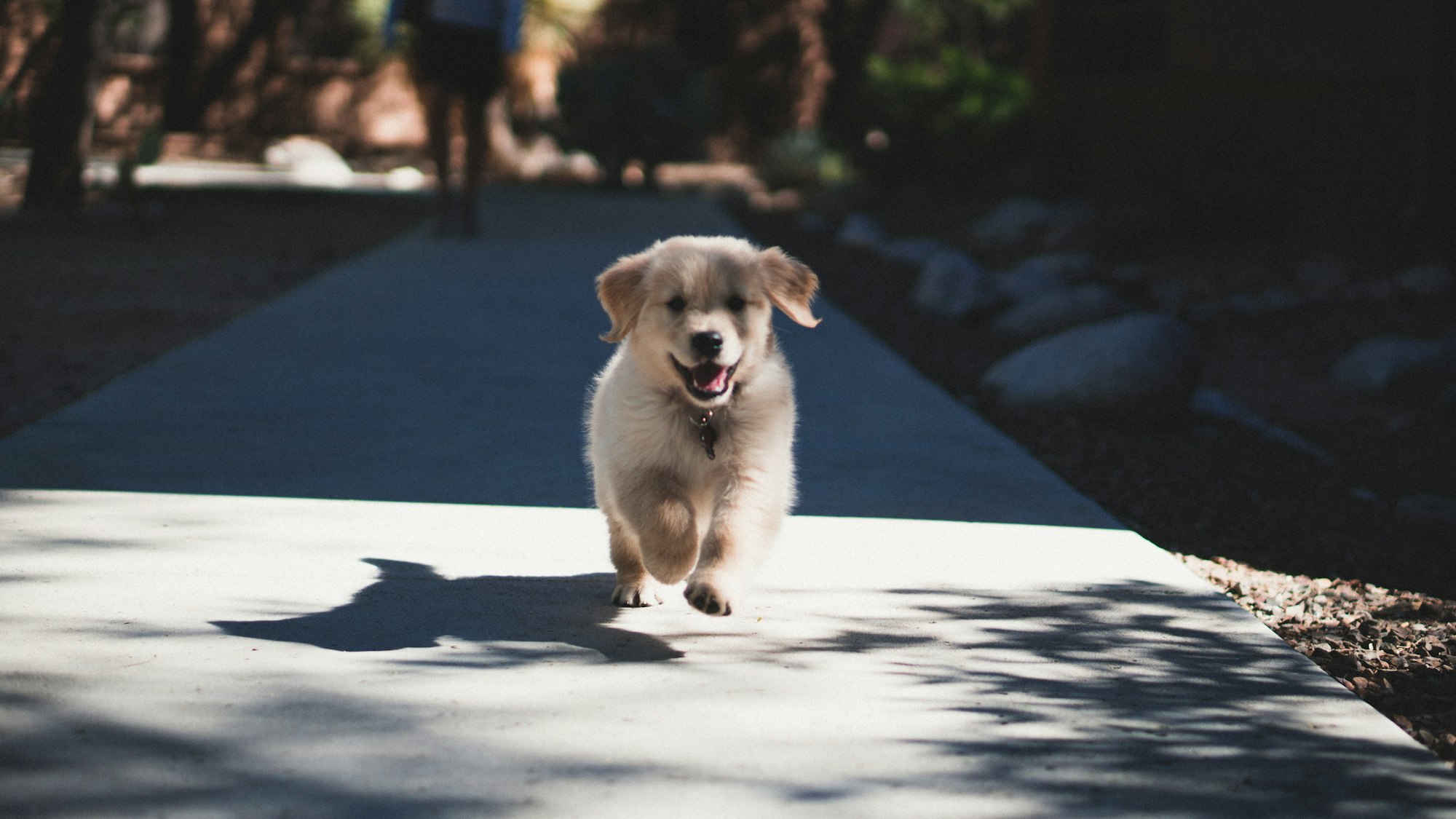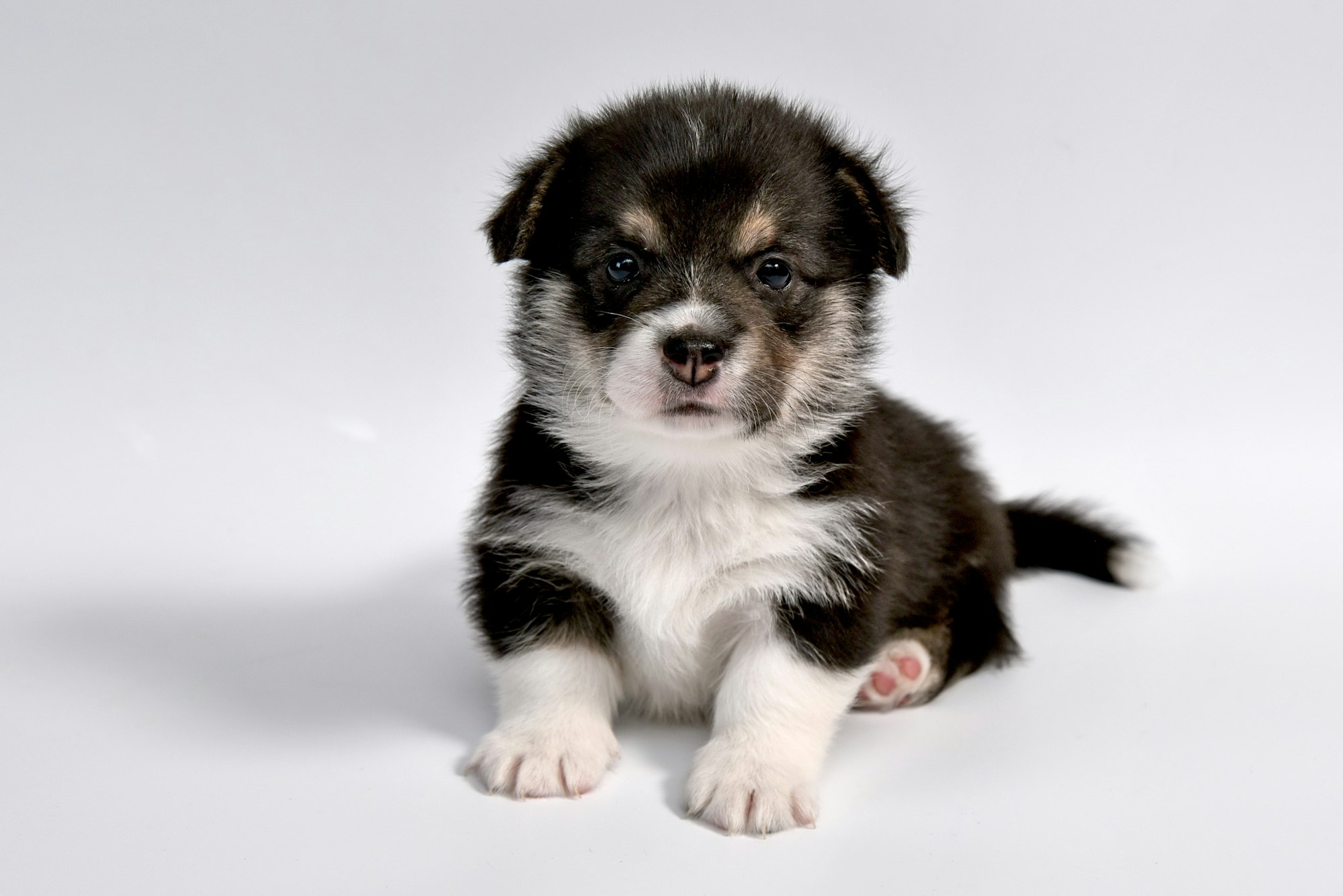Welcoming a new furry friend into your home is an exciting experience, but it comes with its challenges, especially when it comes to fostering confidence in puppies. These early days play a crucial role in shaping a puppy's overall well-being, and as responsible pet owners, it's our duty to ensure they grow into confident and happy dogs.

Understanding Puppy Behavior
Welcoming a playful, energetic puppy into your home is an exciting adventure, but it's essential to grasp the intricacies of their behavior. Puppies, much like human infants, explore the world around them with boundless curiosity. Their actions, whether it's playful bouncing or investigative sniffing, are not just cute antics; they're vital components of their learning and development.
Understanding the typical behaviors displayed by puppies is the first step to effective puppy parenting. Puppies often exhibit bursts of energy, short attention spans, and an eagerness to explore their surroundings. Recognizing and appreciating these behaviors sets the stage for fostering a confident and well-adjusted adult dog.

Signs of Low Confidence in Puppies
Just like humans, puppies can experience moments of self-doubt and uncertainty. Identifying signs of low confidence early on is crucial for providing the necessary support. Common signs may include excessive cowering, persistent hiding, or reluctance to engage in activities they once enjoyed. A lack of confidence can manifest in various behavioral cues, and attentive pet owners can play a pivotal role in addressing these issues.
Pay close attention to your puppy's body language. Averted eyes, tucked tails, or flattened ears may indicate feelings of insecurity. Additionally, if your puppy becomes overly submissive or excessively vocalizes distress, these are clear signals of potential confidence issues.
Building Trust and Bonding
Trust forms the foundation of a strong and confident relationship between you and your puppy. Building this trust involves more than just providing dog food and shelter—it requires time, attention, and positive interactions.
Spending quality time with your puppy is a crucial aspect of bonding. Engage in activities that your puppy enjoys, whether it's interactive play, gentle petting, or going for walks. Creating positive associations with your presence establishes trust, and a trusting puppy is more likely to exhibit confidence in various situations.
Positive reinforcement is a powerful tool in the trust-building process. When your puppy displays confident behavior or successfully navigates a new experience, reward them with praise, treats, or affection. This reinforces the idea that positive actions lead to positive outcomes, boosting their self-assurance.
Positive Reinforcement Training
Positive reinforcement training is a cornerstone in shaping a puppy's behavior, fostering confidence, and building a strong, positive relationship between you and your furry friend. Unlike punitive methods, positive reinforcement focuses on rewarding desirable behaviors, and encouraging your puppy to repeat them.
Start with basic commands such as sit, stay, or come. When your puppy follows a command correctly, immediately reward them with treats, praise, or a combination of both. The key is timing—offer the reward promptly to reinforce the connection between the behavior and the positive outcome.
Consistency is vital in positive reinforcement training. Ensure that everyone interacting with the puppy uses the same commands and rewards for consistency. This not only reinforces the training but also prevents confusion for your puppy.
Positive reinforcement extends beyond formal training sessions. Reinforce good behavior in everyday situations, whether it's walking on a leash without pulling or calmly greeting guests. By consistently rewarding positive behavior, you're actively contributing to the development of your puppy's confidence and understanding of desired behaviors.
Socialization Techniques
Socialization is a critical aspect of a puppy's development, impacting their ability to interact positively with people, other animals, and various environments. Proper socialization sets the stage for a well-adjusted and confident adult dog.
Introduce your puppy to a variety of people, including different ages, genders, and ethnicities. This exposure helps them feel at ease with a diverse range of individuals. Allow your puppy to interact with other friendly dogs in controlled environments, facilitating positive social experiences.
Expose your puppy to different environments and stimuli gradually. Start with familiar surroundings, then gradually introduce them to new places, sounds, and surfaces. This gradual approach prevents overwhelming your puppy, allowing them to build confidence as they explore and adapt to new situations.
Gradual Exposure to Stimuli
Gradual exposure to stimuli is a fundamental aspect of desensitizing your puppy to various sights, sounds, and experiences. This method involves introducing stimuli in a controlled and positive manner, helping your puppy build confidence and resilience.
Identify specific stimuli that may initially cause separation anxiety in your puppy, such as loud noises or unfamiliar objects. Begin with a low-intensity version of the stimulus, exposing your puppy at a comfortable distance. As they become more accustomed, gradually increase the intensity or proximity.
For example, if your puppy is afraid of car rides, start by sitting with them in a stationary car. Gradually progress to short drives, making each experience positive with treats and praise. This gradual exposure builds positive associations and helps your puppy feel secure in different situations.
Interactive Play and Learning
Interactive play is not just a source of entertainment for your puppy; it's a powerful tool for mental stimulation, physical exercise, and building confidence. Engaging in play with your puppy fosters a strong bond and provides opportunities for learning and growth.
Choose toys that encourage problem-solving and stimulate your puppy's natural instincts. Puzzle toys, tug ropes, and treat-dispensing toys are excellent choices. These toys not only entertain but also challenge your puppy mentally, contributing to their cognitive development.
Interactive play sessions should be positive and enjoyable for both you and your puppy. Use playtime as an opportunity to reinforce commands and behaviors learned during training. Incorporate a variety of activities to keep the sessions interesting and help your puppy develop a well-rounded set of skills.
Remember, interactive play is more than just a physical outlet; it's a means of communication and connection between you and your puppy. Be present, use positive reinforcement, and watch as your puppy's confidence blossoms through these engaging interactions.
Consistency in Training
Consistency is the linchpin of successful puppy training. Whether you're teaching basic commands or addressing specific behaviors, maintaining a consistent approach is crucial for your puppy's understanding and confidence.
Establish clear and simple commands for your puppy, and use them consistently across all interactions. If you're teaching your puppy to sit, for example, use the same verbal cue each time. Consistency in your commands helps your puppy associate words with actions, reinforcing their understanding.
Consistency also applies to rules and routines. Establish a consistent daily schedule for feeding, walks, and playtime. Predictability creates a sense of security for your puppy, contributing to their overall confidence. When rules are consistently enforced, your puppy learns boundaries and what is expected of them.
It's important to ensure that everyone in your household is on the same page regarding training methods and commands. Consistency across all family members prevents confusion for your puppy and promotes a unified approach to training.

Overcoming Challenges
Challenges are a natural part of raising a puppy, and overcoming them requires patience, understanding, and a proactive approach. Identifying the specific challenges your puppy faces is the first step in finding effective solutions.
Common challenges include fear of specific stimuli, difficulty with certain commands, or behavioral issues such as excessive barking or chewing. Tailor your approach based on the individual needs of your puppy.
For fear-related challenges, employ gradual exposure techniques, introducing the stimulus in a controlled and positive manner. If your puppy struggles with specific commands, revisit your training methods and ensure consistency in your cues and rewards.
In cases of behavioral issues, address the root cause rather than simply correcting the behavior. For example, excessive chewing may indicate boredom, so providing mentally stimulating toys can be a proactive solution.
Health and Confidence
The connection between a puppy's physical health and their confidence is undeniable. A healthy puppy is not only physically robust but also emotionally resilient. Ensuring your puppy receives proper nutrition, regular veterinary care, and a safe environment contributes significantly to their overall well-being and confidence.
Proper nutrition is the foundation of good health. Consult with your veterinarian to determine the best diet for your puppy's breed, size, and age. A well-balanced diet supports their physical development, energy levels, and immune system, fostering a healthy and confident disposition.
Regular veterinary check-ups are essential for monitoring your puppy's health and catching any potential issues early on. Vaccinations, parasite control, and dental care all play a role in maintaining your puppy's overall health. A healthy puppy is more likely to engage confidently with their surroundings and experiences.
Create a safe and stimulating environment for your puppy to explore. Remove potential hazards, provide comfortable resting areas, and offer a variety of interactive dog toys to keep them mentally engaged. A secure and enriching environment positively influences your puppy's confidence as they navigate and interact with their surroundings.
Monitoring Progress
Monitoring your puppy's progress in building confidence is a dynamic and ongoing process. Paying attention to their behaviors, reactions, and overall demeanor allows you to make informed adjustments to your training and socialization strategies.
Keep a journal or use a digital tracking tool to record your observations. Note specific situations where your puppy displayed confidence or, conversely, moments of hesitation or fear. Look for patterns or triggers that may impact their confidence levels.
Observe their body language, noting changes in posture, tail position, and overall demeanor. Positive signs of progress may include increased curiosity, a wagging tail in new situations, and relaxed body language. On the flip side, signs of stress or low confidence may manifest as avoidance behaviors, excessive panting, or cowering.
Regularly reassess your training methods and adjust them based on your puppy's responses. Flexibility in your approach ensures that you're catering to your puppy's individual needs and building their confidence at a pace that suits them.
Celebrating Achievements
Celebrating your puppy's achievements, no matter how small, is a crucial aspect of the confidence-building journey. Positive reinforcement is not only a training technique but also a way to acknowledge and amplify your puppy's successes.
When your puppy conquers a fear, successfully follows a command, or navigates a new environment with confidence, celebrate the moment. Use enthusiastic praise, treats, and affection to communicate that their behavior is not only appreciated but also rewarded.
Small victories pave the way for more significant accomplishments. Celebrating achievements fosters a positive association with new experiences and reinforces your puppy's self-esteem. It also deepens the bond between you and your furry friend, creating a positive and supportive environment for their ongoing development.
Case Studies
Case Study 1: From Shy to Social Butterfly
Background: Lola, a 4-month-old rescue puppy, exhibited extreme shyness and fearfulness when introduced to new people and environments. Her previous experiences had left her wary and hesitant, hindering her ability to socialize comfortably.

Strategy:
- Gradual Exposure: Lola's owner implemented a gradual exposure plan, starting with quiet and familiar environments. They slowly introduced her to new people, rewarding their calm behavior with treats and praise.
- Positive Reinforcement: Lola's progress was consistently reinforced with positive feedback during social interactions. Treats and affection were used to associate people and new experiences with positive outcomes.
Results: Over several weeks, Lola's confidence grew visibly. She transitioned from avoiding eye contact and cowering to approaching new people with curiosity. The gradual exposure, coupled with positive reinforcement, transformed Lola from a shy pup into a social butterfly, eager to explore and interact.
Case Study 2: Overcoming Leash Reactivity
Background: Max, a 1-year-old Labrador, displayed leash reactivity, reacting aggressively toward other dogs during walks. This behavior was a source of stress for Max's owner, making walks challenging and causing concern about potential harm to other dogs.
Strategy:
- Positive Reinforcement Training: Max's owner focused on redirecting his attention through positive reinforcement. Treats and praise were used when Max remained calm in the presence of other dogs.
- Gradual Exposure to Other Dogs: Controlled introductions to calm and well-behaved dogs were incorporated into Max's routine. Over time, the distance between Max and other dogs was gradually decreased.
Results: Through consistent positive reinforcement and gradual exposure, Max's leash reactivity significantly decreased. He learned to associate the presence of other dogs with positive experiences. Max's walks became enjoyable for both him and his owner, showcasing the effectiveness of positive reinforcement in addressing behavioral challenges.
Case Study 3: Confidence Building in a Formerly Abused Puppy
Background: Charlie, a 6-month-old puppy rescued from an abusive situation, exhibited severe fearfulness and anxiety. His previous experiences had left him emotionally scarred, making it challenging for him to trust humans.
Strategy:
- Building Trust Through Patience: Charlie's owner focused on building trust through patience and gentle interactions. Regular, positive interactions, such as gentle petting and treats, were used to create positive associations.
- Interactive Play and Learning: Play sessions were structured to be interactive and mentally stimulating. Puzzle toys and games were introduced to engage Charlie's mind and build his confidence.
Results: With time and dedicated effort, Charlie's fearfulness decreased. He started seeking out human interactions and engaging in play with enthusiasm. The combination of building trust and providing interactive, confidence-building activities transformed Charlie into a happy and trusting companion.
These case studies highlight the transformative power of targeted strategies in building confidence in puppies. Each dog's unique journey reinforces the importance of individualized approaches, patience, and the positive reinforcement methods employed by dedicated pet owners.
Conclusion
Building confidence in puppies is a rewarding journey that requires time, patience, and dedication. By understanding their behaviors, providing positive reinforcement, and creating a supportive environment, pet owners can set the stage for a confident and well-adjusted adult dog.

FAQs About Building Confidence in Puppies
- How long does it take to see improvements in a puppy's confidence?
- The timeline varies, but consistent efforts may yield noticeable improvements in a few weeks.
- Can older dogs benefit from confidence-building activities?
- Absolutely! While early experiences are crucial, dogs of any age can benefit from confidence-building activities.
- What if my puppy is still fearful despite my efforts?
- Consult with a professional happy dog trainer or behaviorist for personalized guidance.
- Is it possible to over-socialize a puppy?
- Yes, excessive or negative socialization experiences can be counterproductive. Focus on positive interactions and gradual exposure.
- Are certain dog breeds more prone to confidence issues?
- While temperament varies among breeds, individual experiences and socialization play a significant role in a dog's confidence, regardless of breed.